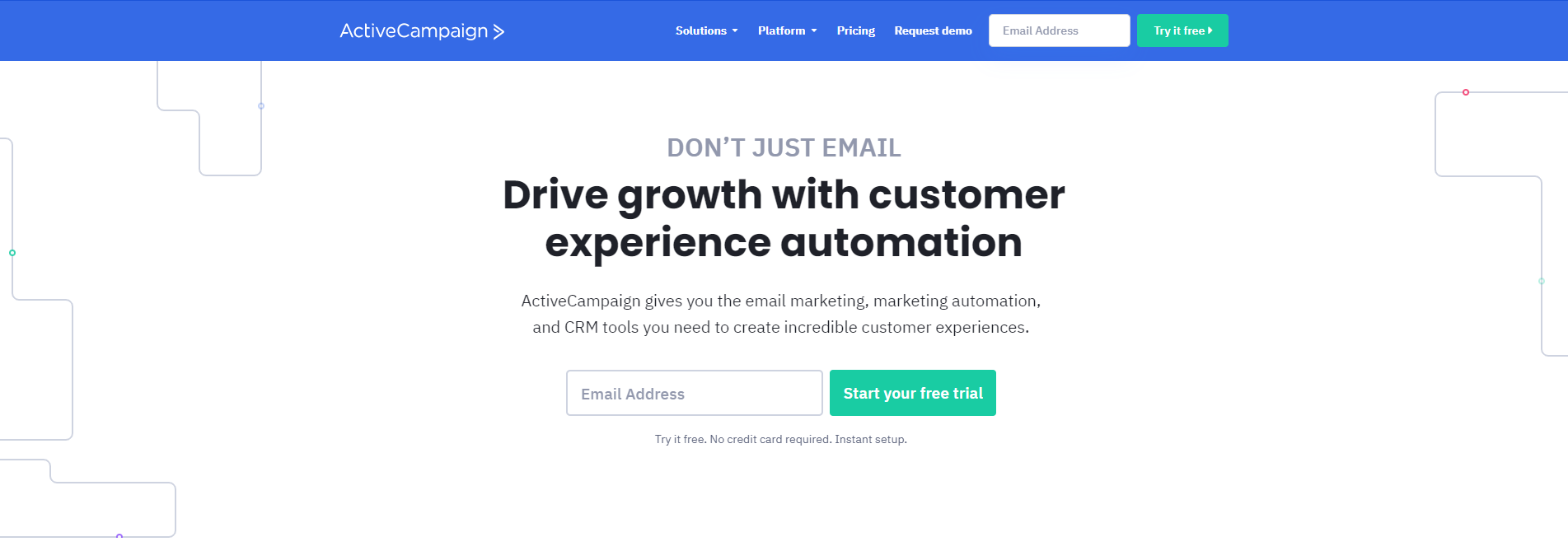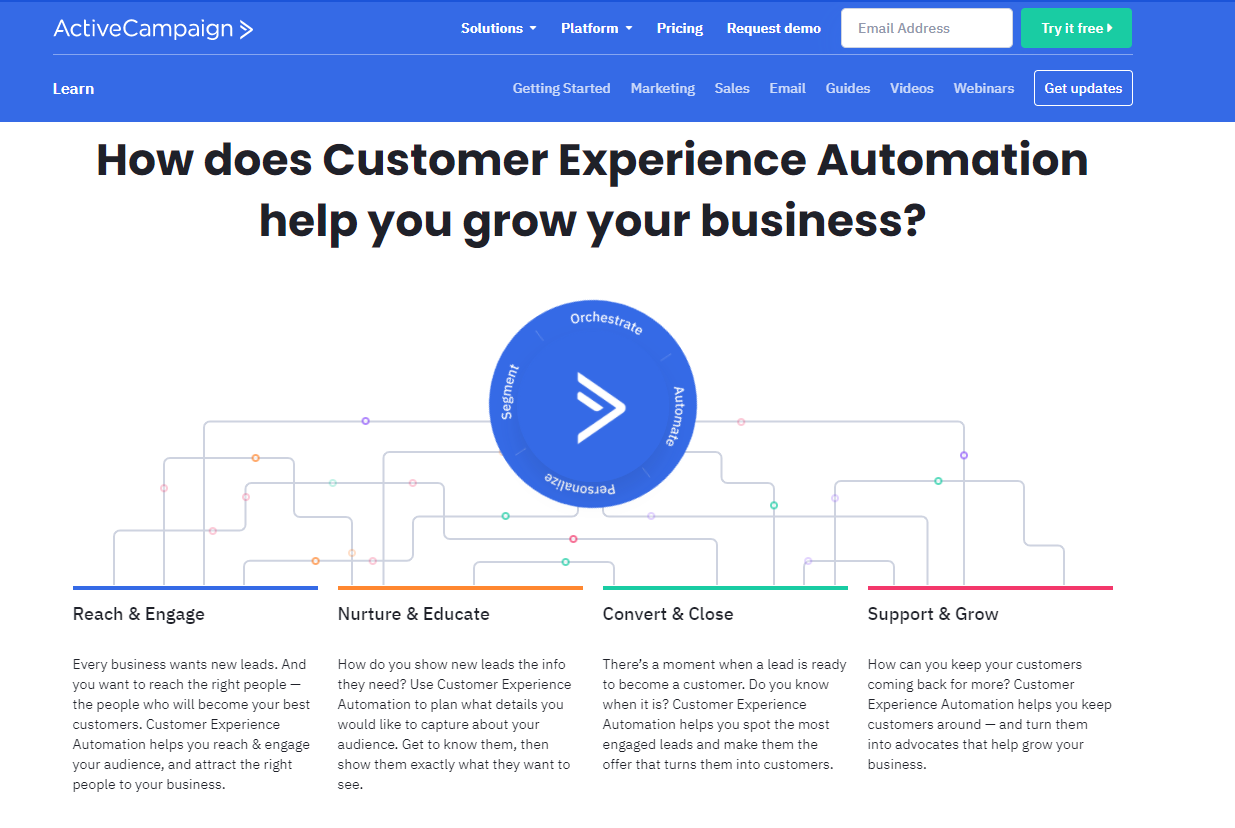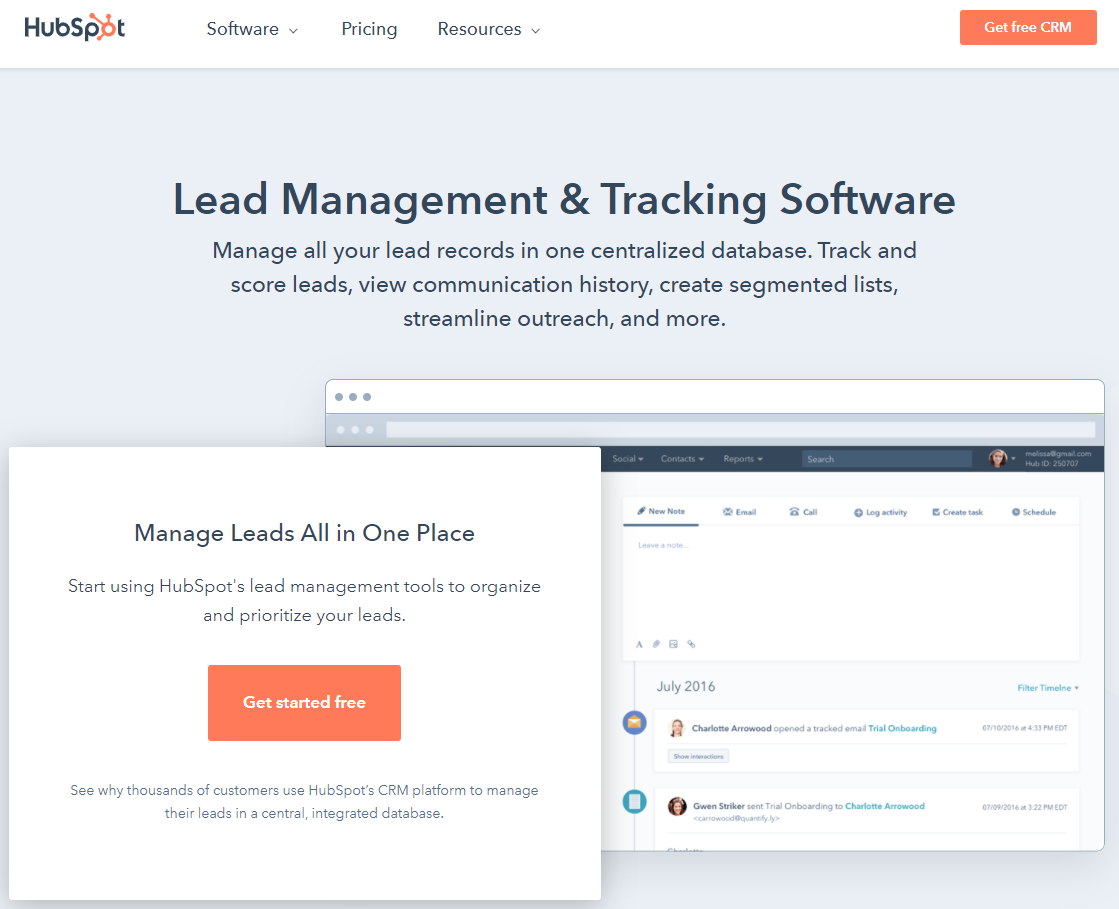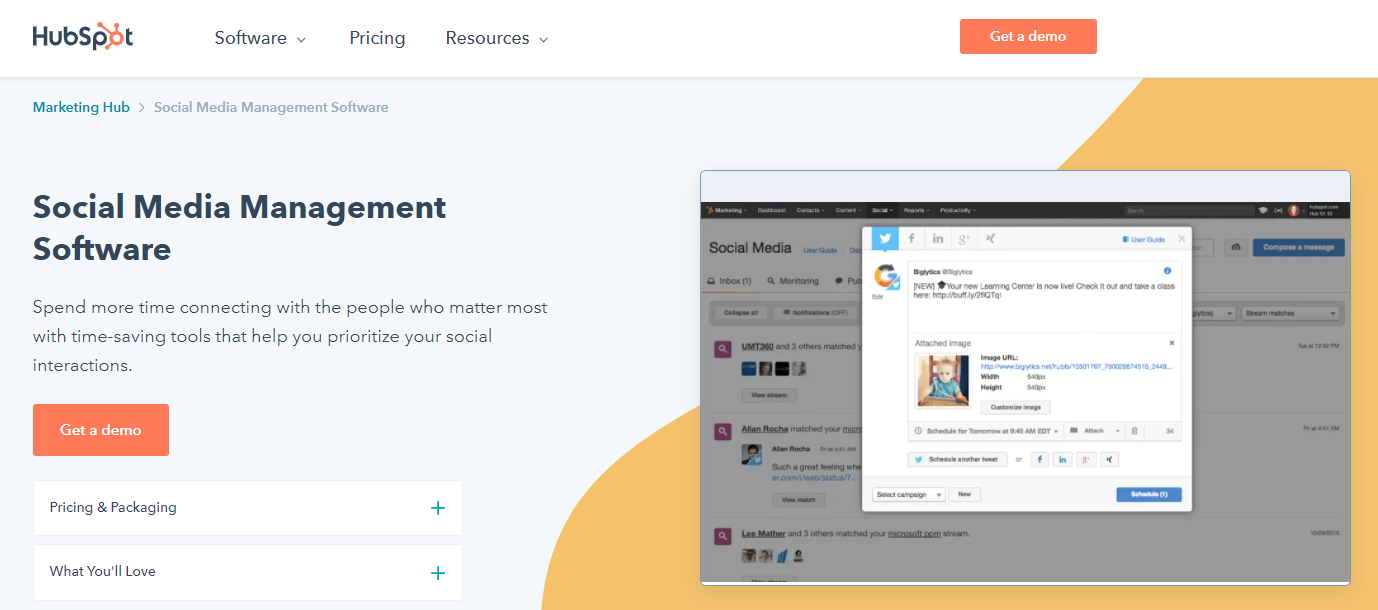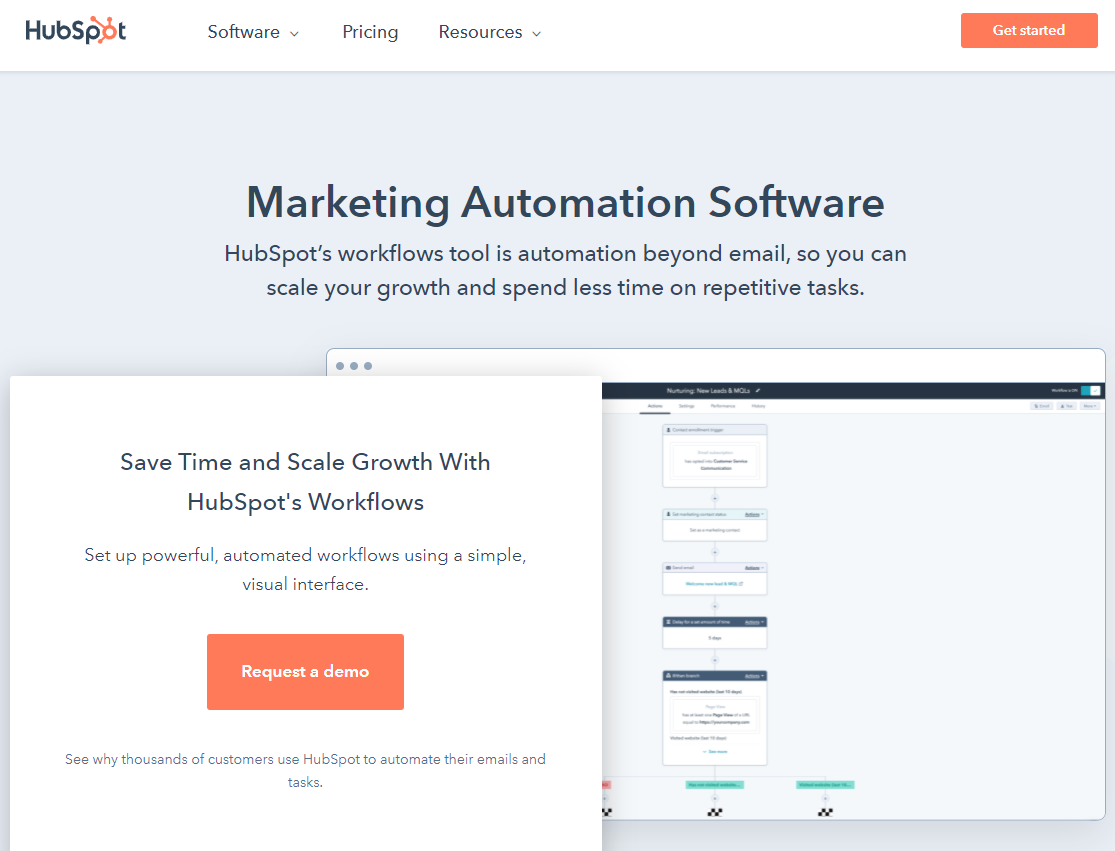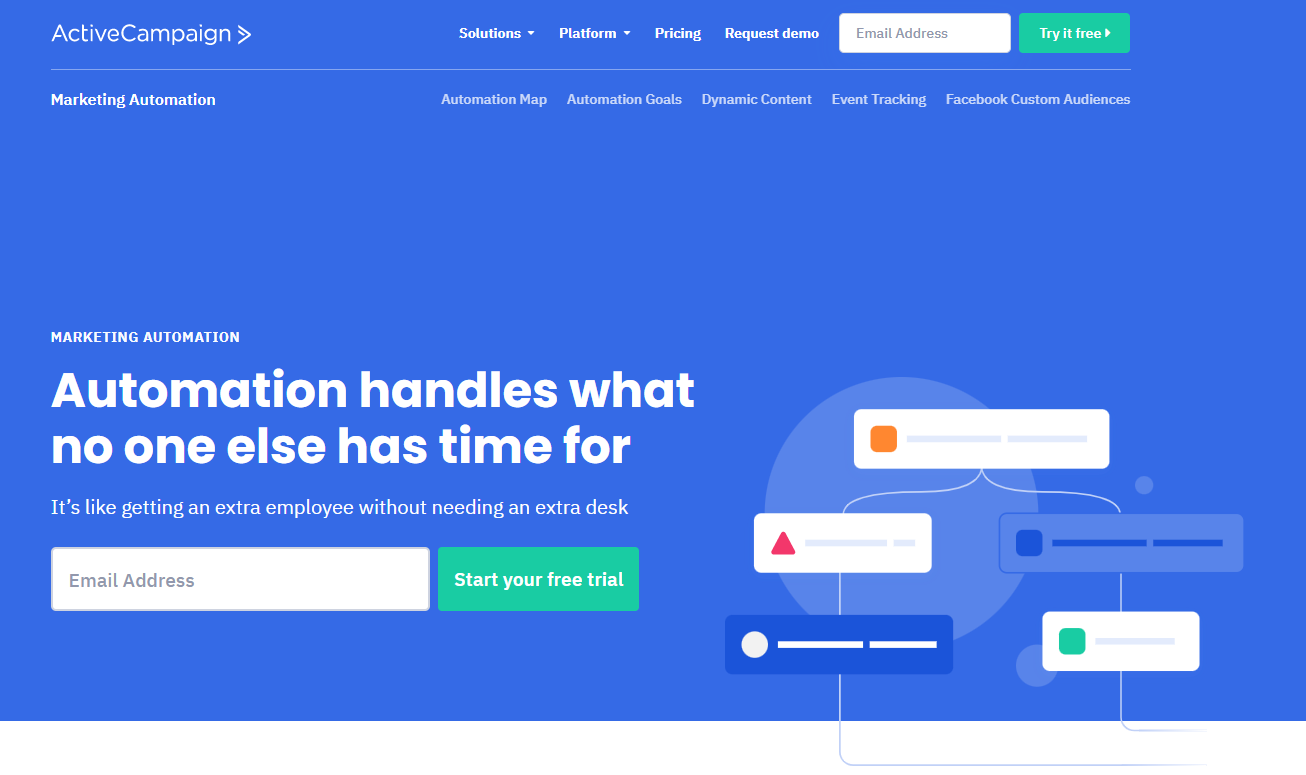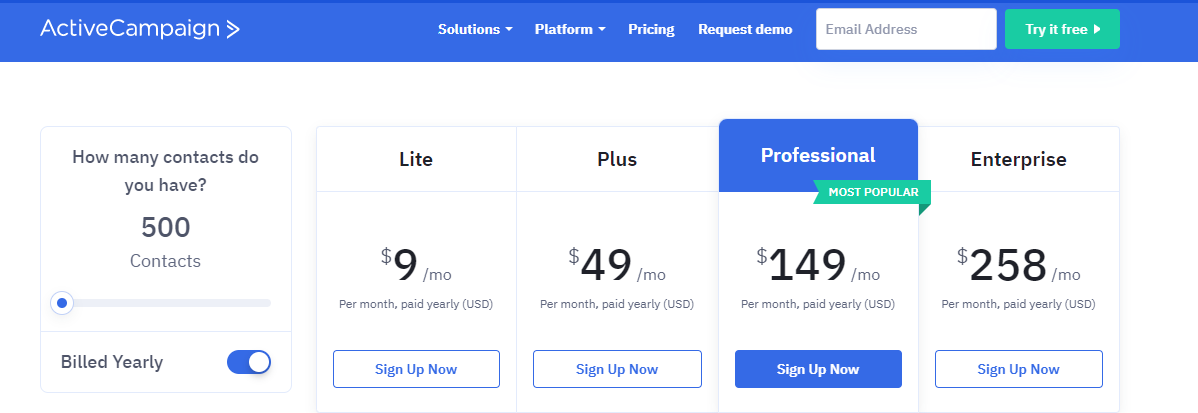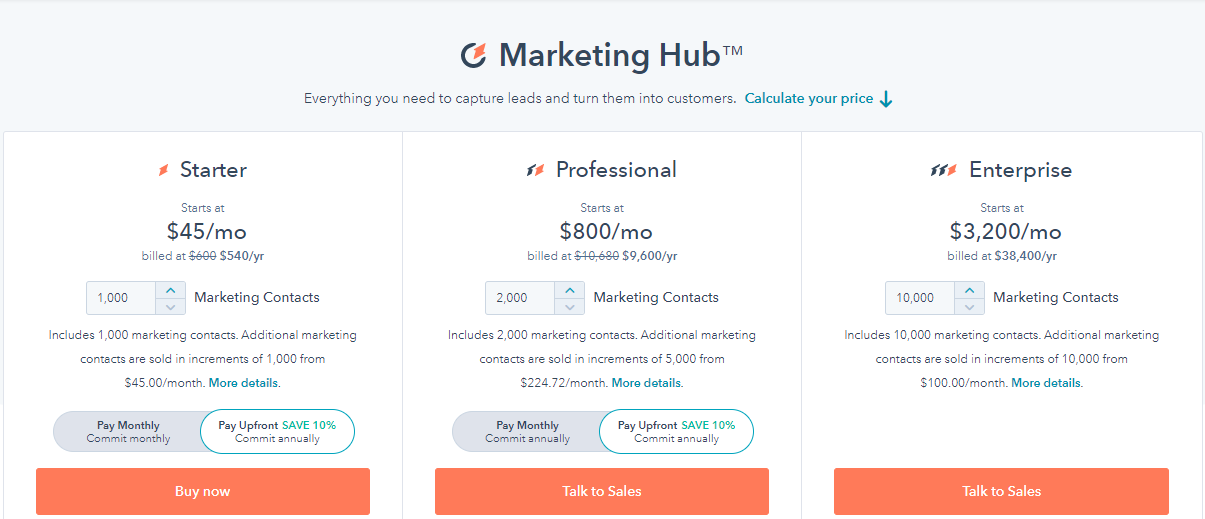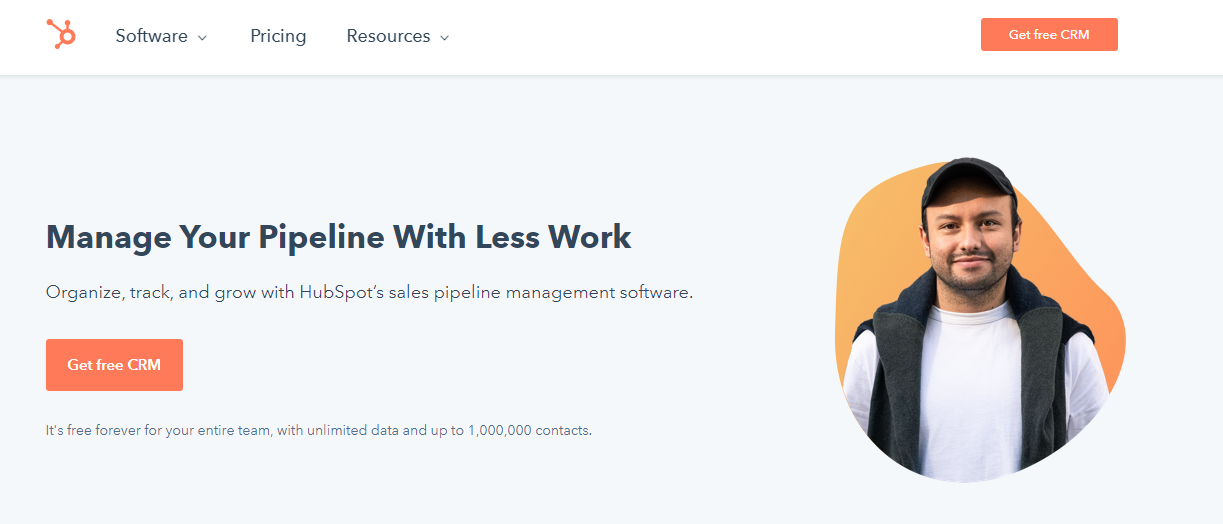HubSpot and ActiveCampaign are cloud-based software applications that offer CRM functionality in addition to other capabilities. You may get perplexed by the ActiveCampaign vs HubSpot comparison and wonder which one is the greatest fit for your needs.
In this article on ActiveCampaign vs HubSpot, we’ll compare the key functionality provided by ActiveCampaign and HubSpot, as well as their price plans and other aspects that will aid you in deciding between ActiveCampaign and HubSpot.
ActiveCampaign Check out
Check out
|
HubSpot Check out
Check out
|
|---|---|
| 9 | 45 |
ActiveCampaign includes lead-generating tools such as landing page builders. This is because it is more concerned with the consumer experience and how it may be improved. |
HubSpot is an excellent CRM and email marketing tool — in fact, we awarded it the best email marketing service thanks to its robust automation and comprehensive reporting. |
|
|
|
|
|
|
|
HubSpot's UI is straightforward and clear, with live chat help available if you run into trouble. |
ActiveCampaign's layout is likewise quite straightforward, and you can customize what you see on your dashboard by adding sections. |
|
ActiveCampaign provides a reasonably priced bundle for individuals serious about marketing automation. It does not offer a free plan. |
HubSpot's Professional package costs $890 per month plus onboarding fees, against ActiveCampaign's $159 per month |
|
ActiveCampaign offers excellent customer support that is available 24/7 The team at ActiveCampaign will be more than happy to assist you. |
HubSpot is the superior alternative. It lags somewhere in facilities of quick responses. |
| Check out | Check out |
CRMs are tools that help businesses improve their customer experience. They are critical for maintaining customer and lead contacts, especially for small organizations.
HubSpot and ActiveCampaign are cloud-based software applications that offer CRM functionality in addition to other capabilities. You may get perplexed by the ActiveCampaign vs HubSpot comparison and wonder which one is the greatest fit for your needs.
In this article on ActiveCampaign vs HubSpot, we’ll compare the key functionality provided by ActiveCampaign and HubSpot, as well as their price plans and other aspects that will aid you in deciding between ActiveCampaign and HubSpot.
ActiveCampaign Vs HubSpot : Detail Comparison
Difference Between ActiveCampaign and HubSpot
ActiveCampaign is a marketing automation platform located in Chicago that is largely geared at email marketers, while HubSpot provides a variety of ‘hubs’ for sales, marketing, and customer care teams.
This plethora of features makes it a bit more diversified product, but you will not have access to its wide collection of features until you pay the required fee. Rather than that, the majority choose a single hub or a cheap bundle (note that this comes with a 12-month commitment).
While ActiveCampaign may not provide the same portfolio of products as HubSpot, it is an excellent CRM and email marketing tool — in fact, we awarded it the best email marketing service thanks to its robust automation and comprehensive reporting.
In contrast to HubSpot, which provides a fairly generous free CRM package, ActiveCampaign gives just a 15-day free trial.
ActiveCampaign’s pricing begins at $15 per month for 500 contacts and gradually increases from there; but, unlike HubSpot, there are no hidden fees (more on prices further down).
Therefore, let us begin!
Lead management: ActiveCampaign Vs HubSpot
Lead management is a vital consideration while selecting the correct CRM. When comparing ActiveCampaign with HubSpot, it’s critical to understand the lead management capabilities offered.
By default, ActiveCampaign includes lead-generating tools such as landing page builders. This is because it is more concerned with the consumer experience and how it may be improved.
Existing contacts in CSV format may be imported into ActiveCampaign. Additionally, these contacts may be tagged and assigned to custom fields if necessary. These custom fields enable you to tailor the data collected across all contact profiles.
The segmentation function in ActiveCampaign enables you to separate your leads. This is often accomplished via a well-executed marketing strategy. Segmentation is used to customize and modify communications depending on client information such as hobbies and interests, geographic location, and so on.
What do you think about HubSpot? Generally, it looks as if HubSpot can devour rival CRMs whole, but this is not the case. The market is large enough for any firm to differentiate itself by including a unique feature.
Hubspot’s lead management solution enables real-time interaction with leads through the CRM contact record. When a new lead is gained by phone or email, the record is instantly updated.
This enables you to keep track of each lead you get and their contact information for further follow-up.
Typically, Hubspot’s lead management solution is coupled with Sales Hub, which is free to use.
ActiveCampaign Vs HubSpot: Sales and CRM
HubSpot has a robust and technologically advanced CRM that enables you to exert exact control over your contacts and how they are managed.
You may pick from a variety of attributes to segment your lists and utilize them to manage your marketing campaigns, all inside HubSpot’s free CRM.
When you go into the details of a contact record, you can observe every interaction you’ve had with the contact, from marketing emails to sales calls and support requests.
You get unique contact information for your future goals. The CRM is integrated with the HubSpot Growth Platform, which ensures that everything is in sync and keeps your teams informed of any contact changes.
You may limit and control your team members’ ability to see contacts. This is especially useful if you have various locations or employees that handle a variety of different sorts of business. The finest feature of the CRM is how simple it is to grasp and use, especially for non-IT users.
Additionally, ActiveCampaign is beneficial to marketers. You can consolidate your contact data and use it to conduct activities like informing the sales team, updating deals, creating tasks, and nurturing leads automatically.
As with HubSpot, you can monitor your contacts’ interactions, which will aid in segmenting your lists based on campaign engagements, social media data, and website activity.
ActiveCampaign Vs HubSpot: Social Media and Ads
HubSpot’s social media and advertising features enable marketers to improve and manage their social media accounts and advertisements in a centralized location.
This generates detailed information on contacts who have interacted with social media postings or clicked on advertising. This connection is very beneficial for marketers since it enables them to take targeted marketing to the next level.
To begin, connect your social network accounts (LinkedIn, Twitter, Instagram, and Facebook) to HubSpot.
Schedule social media postings and track the interaction they generate across several platforms. The social monitoring tool assists you in staying updated about the current trends and search phrases that are critical to the success of your company.
ActiveCampaign also falls short in this area, since it lacks a social tool. To maximize your social media presence in ActiveCampaign, you must connect third-party applications.
This means you will be unable to publish or get reports on your social media activity. You will need to manually add and delete contacts from the list depending on the results of email and advertising campaigns.
Even if the lead was acquired through Facebook advertisements, you must manually add contacts to construct a list.
ActiveCampaign Vs HubSpot: Marketing Automation
HubSpot assists marketers by enabling them to customize their marketing automation. Beyond event monitoring and email follow-ups, the marketing center includes best-in-class and extensive functionality. You may quickly automate tasks by initiating triggers on processes.
When a trigger occurs, such as a form submission, particular page visits, or contact information, the process begins to run. HubSpot’s automation is linked with the Marketing, Sales, and Service Hubs, enabling it to automatically update the status of deals and service tickets.
You may edit contact information and assign it to the appropriate team member. If you want a sophisticated and bespoke procedure, API integrations and technical webhooks may be used.
Assume you’re preparing a promotional campaign. Using HubSpot, you can develop a landing page that includes a form for collecting information about visitors.
The next step is to design and send emails to a list of contacts that include a call-to-action link that will drive them to the promotional landing page.
A/B testing may be used to determine the most effective subject line, which will also assist in optimizing open rates. Following that, you’ll analyze and report on subsequent emails, landing sites, and form submissions to improve the contact’s journey.
The greatest thing is that after you’ve gathered all of your contacts’ information, you can utilize automated workflows with triggers to enroll contacts who filled up the form on the landing page, ensuring that they get timely emails about the deals you’re presenting.
Follow-up emails can assist you in converting contacts into buyers.
ActiveCampaign’s drag-and-drop automation builder enables you to easily create processes. By assigning custom points to certain activities in ActiveCampaign, you can automate email and follow-up, as well as identify your most engaged contacts.
Through the use of event and site tracking in ActiveCampaign, you can monitor your contacts’ behavior on your websites and, depending on that, set triggers for processes.
Additionally, you may tag contacts to make them stand out for the sales team to follow up on based on the updated contact’s status. Despite its powerful marketing automation capabilities, its user interface is a little tough to use and not as robust.
ActiveCampaign Vs HubSpot: Email Marketing
HubSpot developed the phrase inbound marketing and backed marketers with inbound marketing software and best-in-class tools for marketers to express themselves.
HubSpot provides a large selection of email templates and tools for customizing and tailoring email campaigns. The UI is really simple to use, thanks to the drag and drop email editor, and there are several templates to select from and customize.
There are a variety of features, including list segmentation, A/B testing, scheduling, and tokenization for personalization. Email analytics provides insights into campaigns through reports and enables a better understanding of campaign performance.
You may get detailed information about each email, such as its open rate, clicks, and other critical metrics, to determine which emails produce the most clicks.
When combined with the HubSpot CRM, the HubSpot marketing email tool becomes even more effective. With HubSpot, you can develop intelligent email campaigns that are personalized and tailored to the client’s journey.
As your company grows and your contact list grows, it becomes critical to design email campaigns based on consumer activity on web pages or to include nurturing emails into the sales process.
This comprehensive, all-in-one feature sets it apart from ActiveCampaign, as it allows you to manage everything on the move with all the tools in one location.
ActiveCampaign is a marketing automation solution that specializes in email marketing campaigns. It enables the creation of dynamic content, email segmentation, subscription forms, and split testing, all of which contribute to the engagement and nurturing of contacts. Campaigns may be simply created using a drag-and-drop email builder.
The disadvantage of ActiveCampaign’s email editor is that it is not a WYSISYG HTML editor, which makes it challenging to comprehend and continue with specific editing blocks to obtain the required design.
If a marketer’s main objective is email marketing and not other tools, then ActiveCampaign will be beneficial; nevertheless, you will have problems sending one-to-one emails using ActiveCampaign.
ActiveCampaign Vs HubSpot: Pricing
ActiveCampaign’s programs and price structure are straightforward. The plans are determined by the features you desire and the number of contacts. All plans include unlimited email, so you won’t be charged extra if you exceed your allotment.
Prices begin at $15 a month and gradually increase; however, you will notice a significant price increase if you upgrade your plan to include more features ($15 becomes $70 for 500 contacts).
Its plans are divided into Marketing, CRM & Sales, and Service, and each of them has a variety of levels with pricing ranging from $50 to $3200. I’m going to concentrate on the marketing plan here since it most closely resembles ActiveCampaign’s product.
HubSpot’s free CRM package is rather extensive, allowing for unlimited users and 1 million contacts. If you’re comparing ActiveCampaign and HubSpot, you’re probably most interested in the automation, reporting, and analytics tools, which are available solely on the Marketing plan.
While ActiveCampaign does not offer a free plan, when comparing the two platforms’ subscription plans, ActiveCampaign comes out much cheaper.
HubSpot’s Professional package costs $890 per month plus onboarding fees, against ActiveCampaign’s $159 per month. The Professional plans offered by the two carriers are somewhat similar.
While the benefits of adopting HubSpot include access to SEO tips and improvements, a blog, and assistance with content planning, is it worth $890/month? I have my doubts.
ActiveCampaign provides a reasonably priced bundle for individuals serious about marketing automation. Another reason to consider a HubSpot alternative is the hidden fees associated with HubSpot.
As if the pricing weren’t enough, the Professional and Enterprise plan each need a one-time payment of $3,000 and $6,000, respectively, for onboarding. To be honest, I was taken aback by these statistics and so would not suggest HubSpot’s higher-tier plans to small-to-medium-sized businesses.
HubSpot’s inflated charges and hidden fees, in my view, are just not warranted. ActiveCampaign’s price is far more affordable for small enterprises, yet its features are comparable to those of HubSpot. ActiveCampaign takes the victory in this round.
ActiveCampaign Vs HubSpot: Customization & Pipeline Management
Both systems provide a high degree of customization and flexibility. As indicated before, both tools allow you to personalize what appears in the dashboard, so you always have a clear image when you access the platform.
HubSpot takes it a step further by enabling you to create your reporting dashboard and share it with members of your team.In terms of transaction pipeline management, both systems provide significant flexibility.
ActiveCampaign’s stages are completely customizable, allowing you to construct as many as you need to fit your current sales process. If you have many sales processes (for example, one for each product or service you sell), you may also construct a funnel for each.
Additionally, HubSpot enables complete customization, with the added benefit of having many more filters than ActiveCampaign. However, the free HubSpot plan supports just one pipeline, whereas the Starter plan supports two.
You may update columns and add as many custom attributes as you want inside the deals pipeline. As with ActiveCampaign, a search box is included.
Both systems use a drag-and-drop interface to progress transactions through the sales process. If you’re acquainted with Trello, you’ll pick it up fairly immediately.
Both programs provide extensive customization and pipeline management capabilities. Each has certain advantages and disadvantages (e.g. the number of filters available or the number of pipelines that may be configured), which is why I’m granting both a point here. To HubSpot, it’s 1-2.
ActiveCampaign Vs HubSpot: Ease of Use
Choosing a strong solution often entails a high learning curve. Though it is not always the case with these two platforms, I found HubSpot to be significantly simpler to use than ActiveCampaign.
HubSpot’s UI is straightforward and clear, with live chat help available if you run into trouble.
There are many customization choices without being overpowering, as is the case with powerful CRMs like Salesforce. Additionally, there is a useful tour of the program, so you can understand how everything works before you begin.
What’s wonderful is that you can customize your dashboard to display just the data that matters to you, which means less time spent exploring. Additionally, you may see the performance of each of your salespeople immediately on your dashboard.
While ActiveCampaign’s layout is likewise quite straightforward, and you can customize what you see on your dashboard by adding sections such as tasks, campaigns, and top contacts, the menu has a large number of sub-elements, which may result in additional time spent looking.
There is, however, a convenient search box that you may use to locate a certain contact, campaign, or transaction.
One issue that ActiveCampaign users have expressed dissatisfaction with is the inability to add several email addresses to the single contact lead. On the other hand, HubSpot permits it.
Setting up an email campaign is rather basic; tooltips explain how certain elements operate when you hover over them, and there is a live chat widget if you get confused.
The Content Manager area enables you to centralize the storage of all your content assets in one location that is accessible to your whole team.
Adding a deal is easy, and with so many automation templates to choose from, automating everything from contacts and list maintenance to emails and deals is a straightforward and pleasant process.
While both products are simple to use, ActiveCampaign has a little higher learning curve for novices. That is why we award the first point to HubSpot.
Quick Links
FAQs of ActiveCampaign Vs HubSpot
⁉️What is the difference between ActiveCampaign and HubSpot?
ActiveCampaign is a marketing automation platform located in Chicago that is largely geared at email marketers, while HubSpot provides a variety of hubs for sales, marketing, and customer care teams. In contrast to HubSpot, which provides a fairly generous free CRM package, ActiveCampaign gives just a 15-day free trial
🤷♀️What is better than ActiveCampaign?
Apart from BayEngage, other viable alternatives to ActiveCampaign are SendInBlue, ConvertKit, Aweber, SendX, and GetResponse.
😮Can you use ActiveCampaign as a CRM?
Apart from providing clients with a full CRM, ActiveCampaign enables you to send newsletters and other automated campaigns, create landing pages, send SMS messages, and engage website users in tailored 'Conversations' (similar to live chat).
💯What makes HubSpot different?
The HubSpot Content Management System is not like other online content management systems. It is a versatile, scalable, and intuitive website content management system, but it is far from all. The HubSpot Content Management System (CMS) provides organizations with more power, efficiency, and a competitive edge over competing sales and marketing technologies, all in an easier-to-use package.
Final Verdict ActiveCampaign Vs HubSpot 2025
That was close for a while, but ActiveCampaign eventually reclaimed the lead and won the race! I have last seen such a tight head-to-head battle between Pipedrive and HubSpot, which HubSpot prevailed by a hair’s breadth.
What are the important conclusions from this comparison of HubSpot and ActiveCampaign? If you’re a small company owner searching for free customer relationship management software that includes some basic marketing tools, HubSpot’s Free CRM plan is an excellent place to start.
However, as you’ve seen, the premium plans rapidly become prohibitively expensive, while ActiveCampaign’s plans are far more affordable, making it a superior alternative for companies looking to grow.
However, if you’re looking for software that handles everything (and I mean everything connected to digital marketing) and doesn’t mind paying a premium, you should put HubSpot to the test.
You’ll only pay for what you need with ActiveCampaign, and even its entry-level plan includes some very extensive capabilities.
If you’re serious about automation, ActiveCampaign is the way to go since it will save you heaps of time and will almost certainly provide you with a high return on investment.
Both products are available for a free trial.

